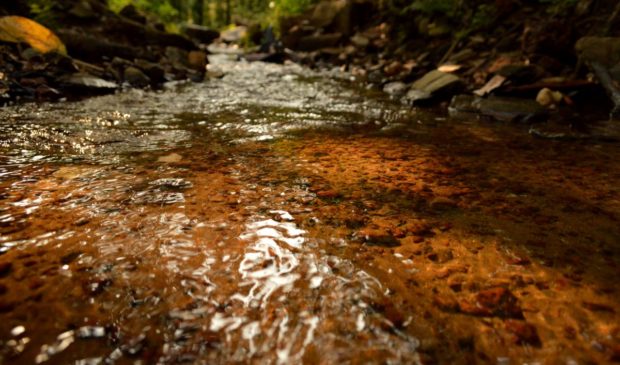Austin’s creeks have many colors – and types of bacteria
Wednesday, January 19, 2022 by
Willow Higgins This winter, scientists across Austin are observing two types of bacteria in local bodies of water; one looks like orange slime, and another has a rainbow sheen. Despite their interesting appearance, the slime is no cause for alarm, according to the Watershed Protection Department.
The orange slime, called ferrihydrite, is a harmless bacteria caused by a chemical reaction. Lack of rainfall and low creek flow has created the perfect environment for the bacteria to prosper this winter, although the natural phenomenon has been present for hundreds of millions of years.
Watershed staff members collaborated to explain the phenomenon to the Austin Monitor.
“Below the surface of the ground, where there is little oxygen, naturally occurring bacteria turns insoluble iron into dissolved iron hydroxide molecules,” staff explained. “These molecules can flow in groundwater to the surface where a different group of bacteria causes a different chemical reaction. This second group of bacteria oxidizes the iron hydroxide, creating an insoluble form of iron called ferrihydrite, which looks like orange slime.”
Despite its rusty appearance, the slime is actually serving a purpose.
“Much of the iron in our soils is naturally occurring, and the soil/aquatic microbes are using them just the way nature intended. Some of the iron is also present due to buried metal pipes, rebar in concrete and other sources that would be expected to slowly corrode over time. These bacteria are part of the recycling process.”
Ferrihydrite has been observed in all watersheds and in various water qualities. The watershed department said it can be seen in pristine preserves as well as urban landfills.
While the phenomenon does slightly change the acidity of the water and can affect the microbial and fungal life around the area, the impact on the ecosystems of the waterways is minor and localized. “We see aquatic insects like dragonfly and mayfly nymphs acting normally on the ferrihydrite, and it appears to be just a temporary inconvenience to the bug community.”
However, as a reminder, people and pets should always avoid water that is warm, stagnant, and/or has a strange appearance or smell.
The rainbow-colored sheen observed in local creeks is called Leptothrix discophora. While it looks like oil sitting atop water, it is actually a bacteria-caused biofilm that floats to the surface.
“The fragile rainbow sheen is a thin layer of iron-oxidizing bacteria that shatter like glass, instead of swirling like oil,” explains a Facebook post from the Watershed Protection Department.
Colleen Robinson Garland, who commented on the department’s Facebook post, noted that she has been observing the rainbow sheen in her galvanized metal pond for a long time.
Watershed put together a color guide of common water quality complaints, including other unusual colors and textures in local bodies of water, to serve as a resource for the community.
The guide includes photos of various abnormalities seen in local water bodies alongside descriptions of their likely causes – some are harmful, others are not. It includes things like fluorescent green creekways caused by antifreeze, dyes or detergents; red water coming from natural berry extract sitting in standing water; and milky white flowing water coming from illegal discharge.
The city’s 24-hour pollution hotline is the place to call to report such observations. Calling (512) 974-2550 will initiate an investigation by the Watershed Protection Spill Response Program.
The watershed department encourages Austinites to get outside and explore the natural world, while being aware of local conditions.
The Austin Monitor’s work is made possible by donations from the community. Though our reporting covers donors from time to time, we are careful to keep business and editorial efforts separate while maintaining transparency. A complete list of donors is available here, and our code of ethics is explained here.
You're a community leader
And we’re honored you look to us for serious, in-depth news. You know a strong community needs local and dedicated watchdog reporting. We’re here for you and that won’t change. Now will you take the powerful next step and support our nonprofit news organization?










